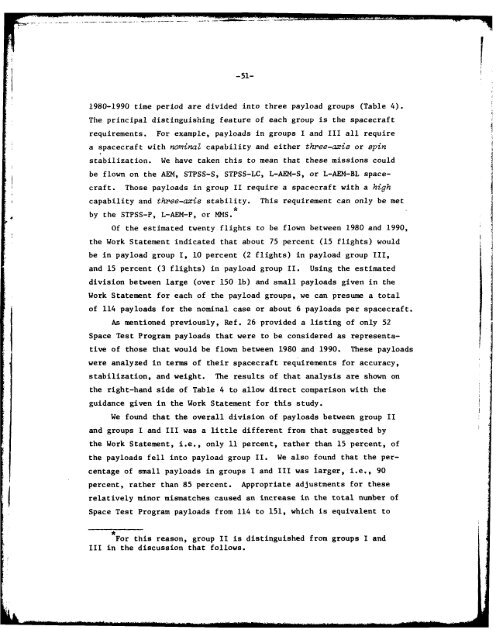A Case Study in NASA-DoD - The Black Vault
A Case Study in NASA-DoD - The Black Vault
A Case Study in NASA-DoD - The Black Vault
You also want an ePaper? Increase the reach of your titles
YUMPU automatically turns print PDFs into web optimized ePapers that Google loves.
-51-<br />
1980-1990 time period are divided <strong>in</strong>to three payload groups (Table 4).<br />
<strong>The</strong> pr<strong>in</strong>cipal dist<strong>in</strong>guish<strong>in</strong>g feature of each group is the spacecraft<br />
requirements. For example, payloads <strong>in</strong> groups I and III all require<br />
a spacecraft with nom<strong>in</strong>al capability and either three-axis or sp<strong>in</strong><br />
stabilization. We have taken this to mean that these missions could<br />
be flown on the AEM, STPSS-S, STPSS-LC, L-AEM-S, or L-AEM-BL spacecraft.<br />
Those payloads <strong>in</strong> group II require a spacecraft with a high<br />
capability and three-axis stability. This requirement can only be met<br />
by the STPSS-P, L-AEM-P, or MIS.<br />
Of the estimated twenty flights to be flown between 1980 and 1990,<br />
the Work Statement <strong>in</strong>dicated that about 75 percent (15 flights) would<br />
be <strong>in</strong> payload group I, 10 percent (2 flights) <strong>in</strong> payload group III,<br />
and 15 percent (3 flights) <strong>in</strong> payload group II. Us<strong>in</strong>g the estimated<br />
division between large (over 150 lb) and small payloads given <strong>in</strong> the<br />
Work Statement for each of the payload groups, we can presume a total<br />
of 114 payloads for the nom<strong>in</strong>al case or about 6 payloads per spacecraft.<br />
As mentioned previously, Ref. 26 provided a list<strong>in</strong>g of only 52<br />
Space Test Program payloads that were to be considered as representative<br />
of those that would be flown between 1980 and 1990. <strong>The</strong>se payloads<br />
were analyzed <strong>in</strong> terms of their spacecraft requirements for accuracy,<br />
stabilization, and weight. <strong>The</strong> results of that analysis are shown on<br />
the right-hand side of Table 4 to allow direct comparison with the<br />
guidance given <strong>in</strong> the Work Statement for this study.<br />
We found that the overall division of payloads between group II<br />
and groups I and III was a little different from that suggested by<br />
the Work Statement, i.e., only 11 percent, rather than 15 percent, of<br />
the payloads fell <strong>in</strong>to payload group II. We also found that the percentage<br />
of small payloads <strong>in</strong> groups I and III was larger, i.e., 90<br />
percent, rather than 85 percent. Appropriate adjustments for these<br />
relatively m<strong>in</strong>or mismatches caused an <strong>in</strong>crease <strong>in</strong> the total number of<br />
Space Test Program payloads from 114 to 151, which is equivalent to<br />
For this reason, group II is dist<strong>in</strong>guished from groups I and<br />
III <strong>in</strong> the discussion that follows.
















